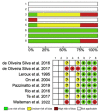Brain and Spinal Cord Adaptations Associated With Patellofemoral Pain: A Systematic Review and Meta-Analysis
- PMID: 35197832
- PMCID: PMC8859985
- DOI: 10.3389/fnint.2022.791719
Brain and Spinal Cord Adaptations Associated With Patellofemoral Pain: A Systematic Review and Meta-Analysis
Abstract
Objective: To evaluate the evidence for altered cortical and spinal cord functions in individuals with patellofemoral pain (PFP).
Methods: We conducted a comprehensive search of databases to appraise and analyze the studies published prior to December 10, 2021 that examined spinal reflex excitability measured using Hoffmann reflex (H-reflex) amplitudes, corticospinal excitability measured using transcranial magnetic stimulation (TMS)-elicited motor evoked potential (MEP) amplitudes, motor threshold (MT), or stimulus-response (SR) curves, cortical reorganization assessed using TMS cortical mapping or structural magnetic resonance imaging (MRI), or functional changes of the brain assessed using functional MRI (fMRI) in individuals with PFP.
Results: Eight studies were eligible for analyses. While an earlier study showed that pain had no effect on the H-reflex amplitude of the quadriceps muscle, more recent evidence reported a decrease in vastus medialis (VM) H-reflex amplitude in participants with PFP. VM H-reflex amplitude was correlated with pain, chronicity, physical function, and isometric knee extensor torque production in participants with PFP. Altered corticospinal excitability was reported in participants with PFP, observed as increased MT in the VM and vastus lateralis (VL) muscles. In addition, cortical reorganization has been observed, where decreased number of cortical peaks, shifts and reduced volumes, and increased overlap of motor cortex representations for the VM, VL, and rectus femoris (RF) muscles were reported in participants with PFP.
Conclusion: There is emerging evidence on altered cortical and spinal cord functions in individuals with PFP, however, solid conclusions cannot be drawn due to limited literature available. Further research is needed to better understand the adaptations of the brain and spinal cord in this population.
Systematic review registration: https://www.crd.york.ac.uk/prospero/, identifier: CRD42020212128.
Keywords: H-reflex; brain; cortical reorganization; corticospinal excitability; neurophysiological adaptation; patellofemoral pain; spinal cord.
Copyright © 2022 Ho, Liang, Budge, Madriaga, Meske and Nguyenton.
Conflict of interest statement
The authors declare that the research was conducted in the absence of any commercial or financial relationships that could be construed as a potential conflict of interest.
Figures



Similar articles
-
Vastus Medialis Hoffmann Reflex Excitability Is Associated With Pain Level, Self-Reported Function, and Chronicity in Women With Patellofemoral Pain.Arch Phys Med Rehabil. 2017 Jan;98(1):114-119. doi: 10.1016/j.apmr.2016.06.011. Epub 2016 Jul 13. Arch Phys Med Rehabil. 2017. PMID: 27422350
-
Patellar Tendon Reflex and Vastus Medialis Hoffmann Reflex Are Down Regulated and Correlated in Women With Patellofemoral Pain.Arch Phys Med Rehabil. 2019 Mar;100(3):514-519. doi: 10.1016/j.apmr.2018.06.024. Epub 2018 Jul 27. Arch Phys Med Rehabil. 2019. PMID: 30059658
-
Relationship between vastus medialis Hoffmann reflex excitability and knee extension biomechanics during different tasks in women with patellofemoral pain.Clin Biomech (Bristol). 2022 Jan;91:105544. doi: 10.1016/j.clinbiomech.2021.105544. Epub 2021 Dec 6. Clin Biomech (Bristol). 2022. PMID: 34896835
-
Modulations in neural pathways excitability post transcutaneous spinal cord stimulation among individuals with spinal cord injury: a systematic review.Front Neurosci. 2024 Mar 25;18:1372222. doi: 10.3389/fnins.2024.1372222. eCollection 2024. Front Neurosci. 2024. PMID: 38591069 Free PMC article.
-
Assessment of Quadriceps Corticomotor and Spinal-Reflexive Excitability in Individuals with a History of Anterior Cruciate Ligament Reconstruction: A Systematic Review and Meta-analysis.Sports Med. 2021 May;51(5):961-990. doi: 10.1007/s40279-020-01403-8. Epub 2021 Jan 5. Sports Med. 2021. PMID: 33400217
Cited by
-
Comparison of gluteal muscle central activation in individuals with and without patellofemoral pain.Front Physiol. 2025 Feb 18;16:1535141. doi: 10.3389/fphys.2025.1535141. eCollection 2025. Front Physiol. 2025. PMID: 40041163 Free PMC article.
-
Exploring the use of bimodal transcranial direct current stimulation to enhance movement in individuals with patellofemoral pain-A sham-controlled double blinded pilot study.Front Hum Neurosci. 2024 Sep 6;18:1427091. doi: 10.3389/fnhum.2024.1427091. eCollection 2024. Front Hum Neurosci. 2024. PMID: 39310792 Free PMC article.
References
-
- Collins N. J., Barton C. J., Van Middelkoop M., Callaghan M. J., Rathleff M. S., Vicenzino B. T., et al. . (2018). 2018 Consensus statement on exercise therapy and physical interventions (orthoses, taping and manual therapy) to treat patellofemoral pain: recommendations from the 5th International Patellofemoral Pain Research Retreat, Gold Coast, Australia, 2017. Br. J. Sports Med. 52, 1170–1178. 10.1136/bjsports-2018-099397 - DOI - PubMed
-
- Crossley K. M., Stefanik J. J., Selfe J., Collins N. J., Davis I. S., Powers C. M., et al. . (2016). 2016 Patellofemoral pain consensus statement from the 4th International Patellofemoral Pain Research Retreat, Manchester. Part 1: Terminology, definitions, clinical examination, natural history, patellofemoral osteoarthritis and patient-reported outcome measures. Br. J. Sports Med. 50, 839–843. 10.1136/bjsports-2016-096384 - DOI - PMC - PubMed
Publication types
LinkOut - more resources
Full Text Sources
Research Materials

